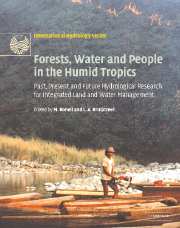 Forests, Water and People in the Humid Tropics
Forests, Water and People in the Humid Tropics Book contents
- Frontmatter
- Contents
- List of contributors
- Foreword
- Preface
- Acknowledgements
- Symposium and Workshop
- Introduction
- Part I Current trends and perspectives on people–land use–water issues
- Part II Hydrological processes in undisturbed forests
- Part III Forest disturbance, conversion and recovery
- 19 Natural disturbances and the hydrology of humid tropical forests
- 20 Spatially significant effects of selective tropical forestry on water, nutrient and sediment flows: a modelling-supported review
- 21 Effects of shifting cultivation and forest fire
- 22 Soil and water impacts during forest conversion and stabilisation to new land use
- 23 Large-scale hydrological impacts of tropical forest conversion
- 24 Forest recovery in the humid tropics: changes in vegetation structure, nutrient pools and the hydrological cycle
- 25 The hydrological and soil impacts of forestation in the tropics
- 26 The potential of agroforestry for sustainable land and water management
- Part IV New methods for evaluating effects of land-use change
- Part V Critical appraisals of best management practices
- Conclusion: Forests, water and people in the humid tropics: an emerging view
- Plate section
- References
22 - Soil and water impacts during forest conversion and stabilisation to new land use
from Part III - Forest disturbance, conversion and recovery
Published online by Cambridge University Press: 12 January 2010
- Frontmatter
- Contents
- List of contributors
- Foreword
- Preface
- Acknowledgements
- Symposium and Workshop
- Introduction
- Part I Current trends and perspectives on people–land use–water issues
- Part II Hydrological processes in undisturbed forests
- Part III Forest disturbance, conversion and recovery
- 19 Natural disturbances and the hydrology of humid tropical forests
- 20 Spatially significant effects of selective tropical forestry on water, nutrient and sediment flows: a modelling-supported review
- 21 Effects of shifting cultivation and forest fire
- 22 Soil and water impacts during forest conversion and stabilisation to new land use
- 23 Large-scale hydrological impacts of tropical forest conversion
- 24 Forest recovery in the humid tropics: changes in vegetation structure, nutrient pools and the hydrological cycle
- 25 The hydrological and soil impacts of forestation in the tropics
- 26 The potential of agroforestry for sustainable land and water management
- Part IV New methods for evaluating effects of land-use change
- Part V Critical appraisals of best management practices
- Conclusion: Forests, water and people in the humid tropics: an emerging view
- Plate section
- References
Summary
INTRODUCTION
The rainforests of the humid tropics are being converted to alternative land uses at an increasing rate (Drigo, this volume). In many cases the initial forest disturbance preceding conversion occurs during mechanised harvesting of (large volumes of) valuable timber (Chappell, Tych et al., Cassells and Bruijnzeel, Thang and Chappell, all this volume). Timber extraction causes a number of disturbances to the soil surface, notably during the construction and subsequent use of haulage roads, tractor tracks and log landings, but also in the form of scars by falling trees, particularly in steep terrain (cf. Kamaruzaman, 1991; Dykstra and Heinrich, 1996). Soil impacts may be lessened in some cases by the manual skidding of logs on wooden rails (usually in relatively flat terrain) or through the use of high-lead or low-lead cable yarding (Figure 22.1) (Bruijnzeel, 1992; Bruenig, 1996). Uphill logging, in which log landings are located on ridge tops, is the preferred system nowadays as this has a number of advantages: (i) access roads can be built along the ridges which usually form the driest part of the landscape, thereby minimising the frequency of road closures during periods of high rainfall; (ii) the log landings are also situated on dry spots which facilitates vehicle operation; (iii) the timber extraction network fans out in a downhill direction, thereby reducing surface runoff accumulation (and thus erosion) on tractor tracks; and (iv) the number of stream crossings is minimised in this way (Dykstra and Heinrich, 1996; cf. Figure 35.4 in Cassells and Bruijnzeel, this volume).
- Type
- Chapter
- Information
- Forests, Water and People in the Humid TropicsPast, Present and Future Hydrological Research for Integrated Land and Water Management, pp. 561 - 589Publisher: Cambridge University PressPrint publication year: 2005
References
- 10
- Cited by


